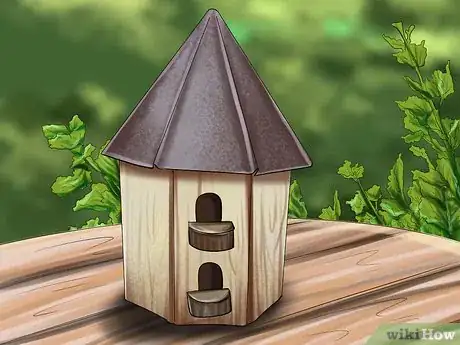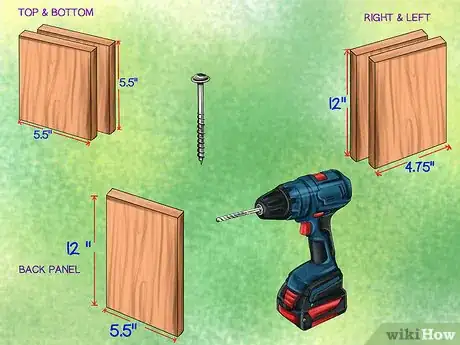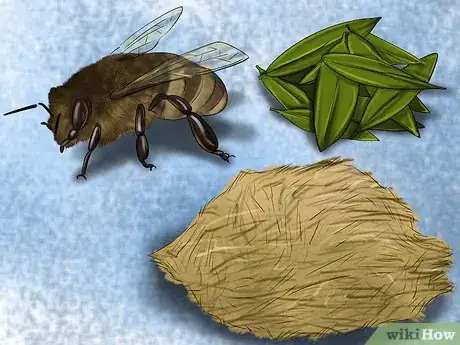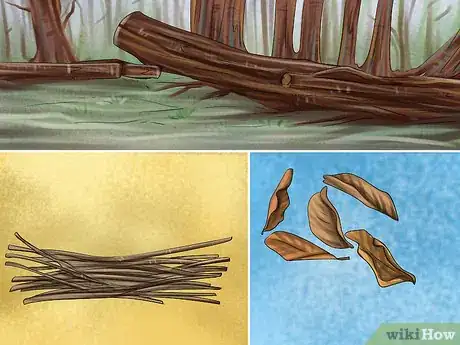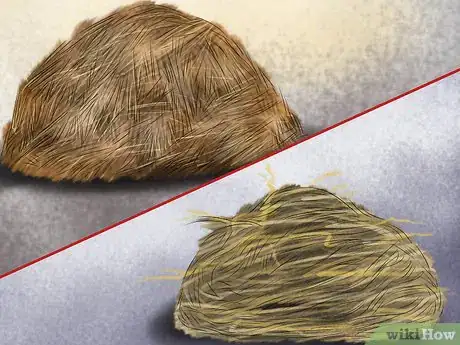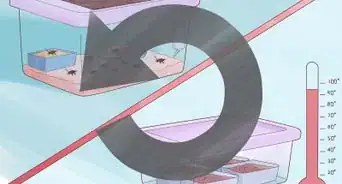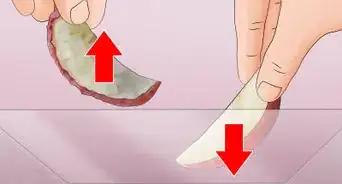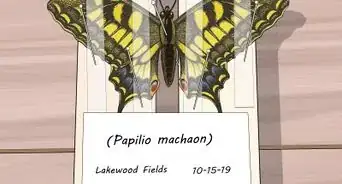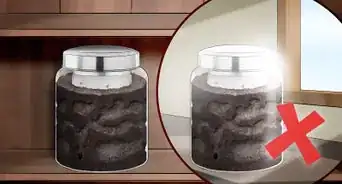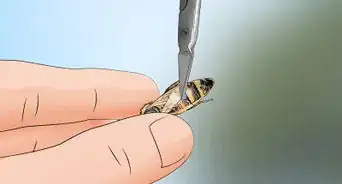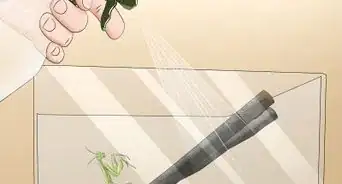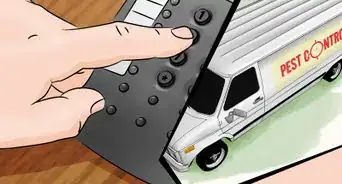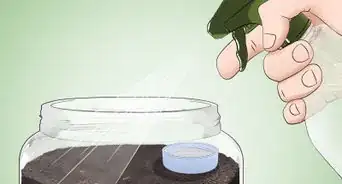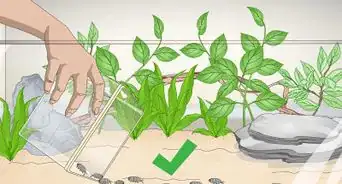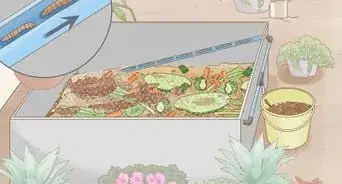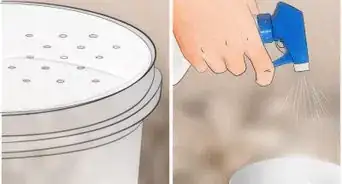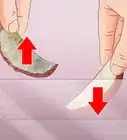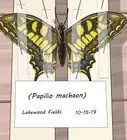This article was co-authored by wikiHow Staff. Our trained team of editors and researchers validate articles for accuracy and comprehensiveness. wikiHow's Content Management Team carefully monitors the work from our editorial staff to ensure that each article is backed by trusted research and meets our high quality standards.
This article has been viewed 30,216 times.
Learn more...
If you're interested in bugs and insects, an insect hotel can be a fun DIY project. An insect hotel is a structure designed to help insects find shelter and build nests. You can use many different structures to make an insect hotel, depending on how big of a hotel you want. From there, fill in the hotel with suitable materials for insects. Choose a safe place outside to set up your hotel.
Steps
Choosing a Location
-
1Select a location in your yard. When looking for a location for your hotel, find an area in your yard close to other wildlife features. These are areas where it's likely bugs already linger. If you have a pond, this may be a good location. You may also want to set up your hotel near a bush, tree, or shrub.
-
2Pick a spot that catches both sun and shade. An insect hotel is meant to cater to a variety of insects. Invertebrates often prefer dark and damp environments, while bees and butterflies like sunshine. You want to place your hotel in an area that gets both sun and shade.
- An area near a large tree or hedge can be particularly helpful when it comes to catching shade and sunlight.
- Hive-like structures and nectar-producing plants cater to bees and butterflies, and should be placed on the sunny site.
- Dry twigs, straw, and hay cater more to invertebrates, and should be placed in the shade.
Advertisement -
3Make sure your hotel is on a flat surface. You do not want your hotel to fall over. This could injure and potentially kill insects that seek shelter. Therefore, make sure the surface where you set your hotel is level. If you find a surface is bumpy or uneven, pick another spot for your insect hotel.
Choosing a Structure
-
1Try an old birdhouse. You may not want to make an incredibly big insect hotel. If you're just looking for something small to place in your backyard, go for an old birdhouse. An old wooden birdhouse can be easily repurposed as a bug hotel.[1]
- You can really use any old wooden box. It's better to reuse materials than to end up throwing them away.
- If you're no longer using a small chest or toy box, you can use this as the structure of an insect hotel.
-
2Use pallets and cinderblocks. Some people want a very large insect hotel. This can be easily made by using old pallets and cinderblocks to create a tall structure. If you don't have old pallets lying around, you can make a trip to the hardware store. However, any long flat object, like old boards of wood, can be used instead.
- First, select where you want to place your structure. Then, place four cinderblocks on the ground in a rectangle shape and lie the pallets across them to form a floor-like structure.
- Place four more cinderblocks on top of the pallets, then build another floor. You can add as many stories as you would like to your bug hotel,
-
3Construct a box from cedar pieces. You can also build your own structure for an insect hotel using cedar pieces. Much like an old birdhouse, cedar pieces will make for a fairly small hotel. You will need two cedar pieces of 5 1/2″(h) x 5 1/2″(w) for the top and bottom. The back panel will be 12″(h) x 5 1/2″(w). The right and left panel will be 12″(h) x 4 3/4″(w). You can get cedar cut at a local hardware store.[2]
- Use a power drill to drill holes in the cedar box, and then use weather-resistant screws to piece the different parts together.
- Screw the right and left panel onto the top and bottom panel. This will give you a rectangular outline that you can easily place over the bottom panel.
- Then, drill the bottom panel in place.
Filling the Hotel
-
1Consider the type of bugs in your area. Ideally, an insect hotel will be appealing to a wide variety of bugs. However, there may be a particular type of bug you want to attract. You may also know a certain type of bug is particularly prevalent in your backyard. In this case, you may want to prioritize certain materials when filling your insect hotel.
- If you have bees in your yard, rolled-up bits of paper and leaves can provide hive-like holes for them. This may keep them from building hives in unwanted areas.
- Dry materials, like straw, hay, and leaves, are great for invertebrates. Invertebrates include worms, crickets, cockroaches, millipedes, and mosquitos.[3]
- If you have a lot of butterflies and bees in your yard, you may want to put potted nectar-producing plants in your insect hotel.
-
2Create holes. Many different types of bugs like to have crevices to hide in. It's a good idea to have at least one section of your insect hotel full of holes.
- Put hollowed-out plants stems into a drain pipe. Then, place that drain pipe into a section of the insect hotel to make an excellent shelter for bees.
- You can also pack one section of the hotel full of rows of rolled-up papers. Try to make holes of various diameters so they'll cater to many different insects.[4]
- Try drilling smaller holes into a piece of wood, then set the wood into one corner of your hotel. Small holes may be better for smaller insects.
-
3Gather materials outside. You want to fill your insect hotel with as many items as possible. Once you've made a few sections dedicated to holes, find materials outside. Place these materials in other sections of the insect hotel, forming a busy habitat that caters to many different types of bugs. You should look for the following when building your insect hotel:
- Dead wood
- Dry leaves
- Old bark
- Dry sticks and twigs[5]
-
4Add straw and hay. In addition to gathering materials outside, you should purchase straw and hay for your house. Straw and hay create cracks and crevices. They also provides invertebrates the option of burrowing and hibernating in the soft material.
Community Q&A
-
QuestionWhat other things does an insect house have to have?
 BlacktailscorpionCommunity AnswerPlants. The plant-eating bugs eat plants in order to survive. If you don't provide plants, all the plant-eating bugs may die unless they feed on wood and the other meat-eating bugs will die because they don't have food. Otherwise, they will leave.
BlacktailscorpionCommunity AnswerPlants. The plant-eating bugs eat plants in order to survive. If you don't provide plants, all the plant-eating bugs may die unless they feed on wood and the other meat-eating bugs will die because they don't have food. Otherwise, they will leave. -
QuestionCan I make it out of cardboard and keep it inside?
 Community AnswerYes, just as long as it doesn't get wet. And make sure that the box has plenty of ventilation so it doesn't get too warm or there is no airflow.
Community AnswerYes, just as long as it doesn't get wet. And make sure that the box has plenty of ventilation so it doesn't get too warm or there is no airflow. -
QuestionWhat if I don't have any wood to build it?
 Lisa Marie WeltonCommunity AnswerYou could use a different material (e.g. cardboard, plastic, etc.) Just make sure that the material you use instead is sturdy so that the insect hotel doesn't crumble to pieces. Also, the material should be suitable for the outdoor environment, not overheat and have good airflow.
Lisa Marie WeltonCommunity AnswerYou could use a different material (e.g. cardboard, plastic, etc.) Just make sure that the material you use instead is sturdy so that the insect hotel doesn't crumble to pieces. Also, the material should be suitable for the outdoor environment, not overheat and have good airflow.
References
- ↑ https://inhabitat.com/diy-how-to-build-an-insect-hotel-from-found-materials/
- ↑ http://gardentherapy.ca/build-a-bug-hotel/
- ↑ https://www.buglife.org.uk/common-names
- ↑ https://inhabitat.com/diy-how-to-build-an-insect-hotel-from-found-materials/
- ↑ http://www.wildaboutgardens.org.uk/thingstodo/inaweekend/bug-mansion.aspx
About This Article
To make an insect hotel, pick a flat spot in your yard that gets both sun and shade, like near a large tree or hedge. Next, choose a structure for your hotel, like an old birdhouse, a wooden box, or cinder blocks. Then, fill the structure with materials that appeal to insects, such as rolled up bits of paper, straw, hay, old bark, and leaves. Finally, create small holes and crevices in the material to give the insects places to hide and take shelter. For more tips on filling your hotel with insect-friendly material, read on!



